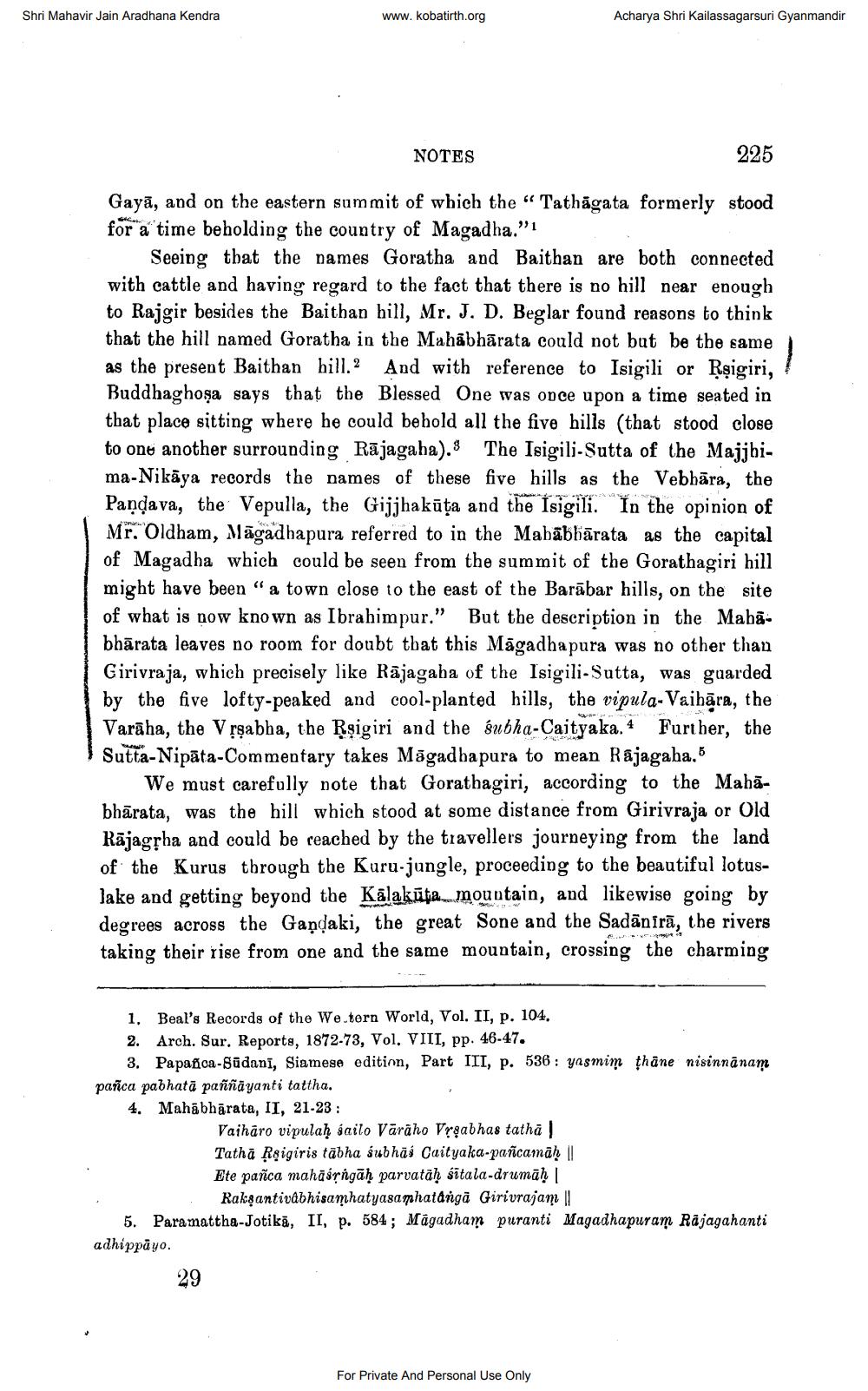________________
Shri Mahavir Jain Aradhana Kendra
www.kobatirth.org
Acharya Shri Kailassagarsuri Gyanmandir
NOTES
225
Gayā, and on the eastern summit of which the " Tathāgata formerly stood for a time beholding the country of Magadha."1
Seeing that the names Goratha and Baithan are both connected with cattle and having regard to the fact that there is no hill near enough
jgir besides the Baithan hill, Mr. J. D. Beglar found reasons to think that the hill named Goratha in the Mahābhārata could not but be the same as the present Baithan hill.2 And with reference to Isigili or Rsigiri, Buddhaghoşa says that the Blessed One was once upon a time seated in that place sitting where he could behold all the five hills (that stood close to one another surrounding Rājagaha). The Isigili-Sutta of the Majjhima-Nikāya records the names of these five hills as the Vebhāra. the Pandava, the Vepulla, the Gijjhakūta and the Isigili. In the opinion of Mr. Oldham, Māgadhapura referred to in the Mabābhārata as the capital of Magadha which could be seen from the summit of the Gorathagiri hill might have been " a town close to the east of the Barābar hills, on the site of what is now known as Ibrahimpur." But the description in the Mabābhārata leaves no room for doubt tbat this Māgadhapura was no other than Girivraja, which precisely like Rājagaba of the Isigili-Sutta, was guarded by the five lofty-peaked and cool-planted hills, the vipula-Vaihāra, the Varāha, the V rşabba, the Rsigiri and the subha-Caityaka. 4 Further, the Sutta-Nipāta-Commentary takes Māgadhapura to mean Rajagaba,
We must carefully note that Gorathagiri, according to the Mahābhārata, was the hill which stood at some distance from Girivraja or Old Rājagặha and could be reached by the travellers journeying from the land of the Kurus through the Kuru-jungle, proceeding to the beautiful lotuslake and getting beyond the Kālakūta... mountain, and likewise going by degrees across the Gaņdaki, the great Sone and the Sadānīrā, the rivers taking their rise from one and the same mountain, crossing the charming
1. Beal's Records of the We.tern World, Vol. II, p. 104, 2. Arch. Sur. Reports, 1872-73, Vol. VIII, pp. 46-47.
3. Papasca-Sudani, Siamese edition, Part III, p. 536 : yasmim thane nisinnānam pañca pabhatā paññāyanti tattha. 4. Mahābhārata, II, 21-23 :
Vaihāro vipulah sailo Väräho Vrgabhas tatha | Tathā Rşigiris tābha śubhāś Caityaka-pañcamāh || Ete pañca mahāśrngāḥ parvatāḥ śitala-drumā)
Rakşantivabhisamhatyasamhatángã Girivrajam || 5. Para mattha-Jotikā, II, p. 584 ; Magadham puranti Magadhapuram Rajagahanti adhippāyo.
29
For Private And Personal Use Only




